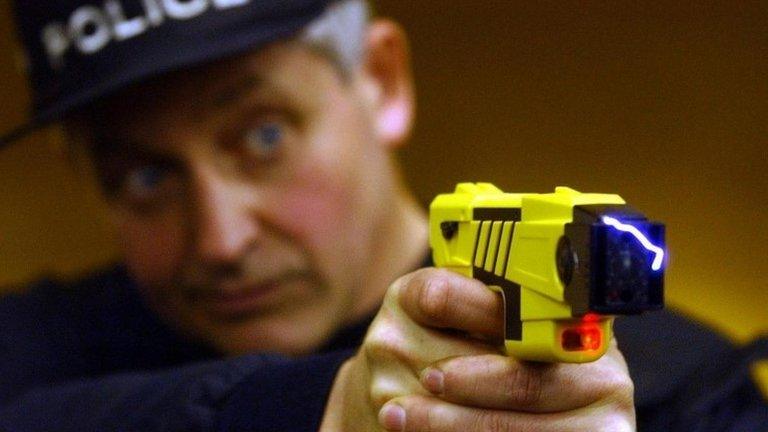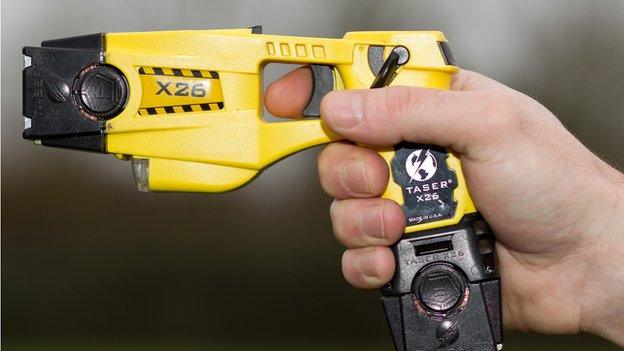Taser use by police rises across England and Wales
- Published

Police fired Tasers or used them to stun 1,921 times in 2014-15
Police in England and Wales drew their Tasers more than 10,300 times last year - 234 more than the previous 12 months.
However figures reveal they were fired or used to stun in fewer than one-in-five incidents, on 1,921 occasions.
Separate data shows there are 5,647 firearms officers, the lowest level for at least six years.
The National Police Chiefs' Council said Taser use was "responsible" and that forces now worked together more on firearms.
The Independent Police Complaints Commission (IPCC) said the figures showed Tasers were now being drawn more as a "deterrent", without being discharged.
There were 8,408 occasions where the police drew a Taser, including aiming it and using its targeting mechanism, but did not fire it, compared with 8,105 the year before.
However the number of times Tasers were fired or used to stun dropped 3%, from 1,989 occasions in 2014 to 1,921 in 2015.
Officers also fired guns six times while the number of firearms operations fell to 14,666, compared to 14,939 in 2014 and 23,181 in 2009 - a drop of 37% over six years.
Greater Manchester Police officers discharged Tasers, either firing them or using them to stun at close quarters, 232 times in 2015. This was the highest use per head of population in England and Wales.
As well as firing a Taser, where probes are attached to copper wires, officers can also deliver an "angled drive stun", which involves fire the weapon up close, or a "drive stun", which is a simple jab.
'Deterrent'
Nottinghamshire has seen the biggest percentage fall in the number of authorised firearms officers, a drop of 61% since 2009, according to the Home Office data.
A spokesman for Nottinghamshire Police said there had been a "sustained reduction" in firearms incidents since the early 2000s and it had redeployed officers to other roles, while working with other forces in the East Midlands.
Meanwhile Avon and Somerset bucked the trend by recording a six-year high in firearms operations and a rise of 82% in a year. The data showed there were 369 firearms operations in 2014-15, compared with 203 the year before.
Sarah Green, deputy chairwoman of the IPCC, said: "Today's statistics show that police officers are increasingly likely to use Taser as a deterrent, without discharging it.
"That's a positive shift, alongside a drop in both the overall use of Taser and its use in so-called drive-stun mode - something we have long believed is both inappropriate and counter-productive. We will continue to share the learning from our investigations to recommend that Taser is used only where appropriate and necessary."
National Police Chiefs' Council lead for Tasers, Deputy Assistant Commissioner Neil Basu said the statistics showed "officers are using Tasers responsibly".
He said: "More situations are now being resolved without a Taser being fired. The number of discharges of Taser are down 4% and in eight out of 10 occasions its mere presence is enough to resolve a violent or potentially violent situation.
"When officers do need to draw their Tasers, they are trained to do so in a proportionate and responsible manner."
The council's lead for armed policing, Deputy Chief Constable Simon Chesterman said the drop in authorised firearms officers was down to "collaborative arrangements" with armed officers working regionally rather than in individual forces.
Following the terrorist attacks in Paris and Brussels, there are plans to recruit and train an extra 1,500 officers over the next 18 months.
"Recruitment to those roles will be a challenge," Mr Chesterman said. "New authorised firearms officers will be existing police officers who volunteer for a highly responsible and dangerous job to protect the public.
"These officers will want reassurance that in the rare event that they discharge their weapons they will be treated as highly trained professionals who were carrying out their duty on behalf of the state, with the intention of protecting the communities they serve."
Policing minister Mike Penning said more information should be given on how and when Tasers are used.
He said: "These statistics provide a snapshot of the use of Taser but we have been clear that the public need greater transparency still. That is why we are implementing the recommendations of the Shaw Review, so that police forces publish ethnicity, age, location and outcome information on all serious use of force, including Taser, by police officers.
"The use of firearms by the police should always be a last resort, considered only where there is a serious risk to public or police safety."
- Published10 September 2013

- Published25 February 2015
